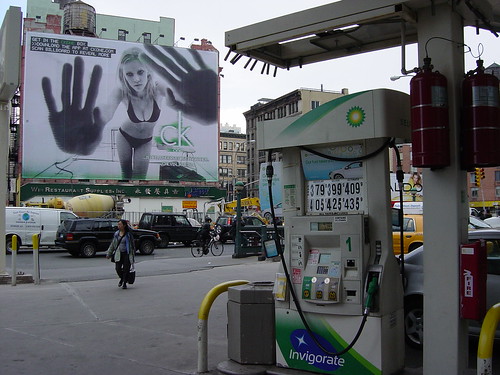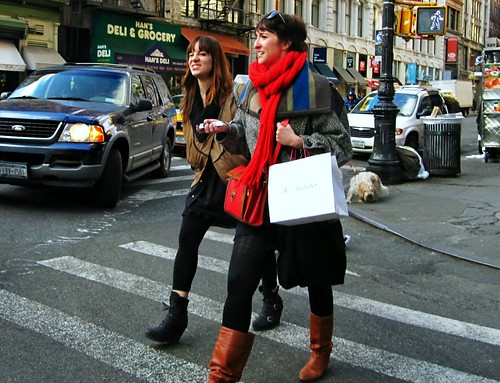For those locals who took a quick glance at accident statistics for New York City compiled by Transportation Alternatives, it probably came as little surprise that the East Village is home to two of the city’s most perilous intersections.
The intersection of Third Avenue and East 14th Street tied for the fifth most dangerous intersection in Manhattan with 66 crashes involving pedestrians from 1995 to 2005.
Bowery and West Houston Street tied for the most dangerous intersection in the entire city with 29 crashes involving cyclists.
Now that Transportation Alternatives has unveiled a plan that it believes will help make streets safer, The Local decided to pay a visit to 14th Street between Second and Third Avenues to talk to residents and business owners about the area’s dubious place as one of the city’s most treacherous stretches of asphalt.
NYU Journalism’s Claire Glass reports.
 Cary Abrams
Cary AbramsOne of the blessings New York City residents enjoy is living in one of the few places in America where it is possible to exist without owning an automobile. In fact, three out of four Manhattanites do not own a car. They miss out on the city’s fabled alternate side of the street parking rituals. They are unable to experience the jolting sensation of driving over the current epic crop of potholes making the streets an urban minefield, and fail to become apoplectic, sitting in lengthy traffic jams or searching for one of those few rapidly disappearing relics, a gas station.
A byproduct of Lower East Side gentrification has been the demolition of the many of the gas stations that once lined the heavily traveled Bowery and Houston Streets. The Bowery Hotel towers over the site of a two story building formerly housing a gas station and taxi garage that some claim is still haunted by the spirit of a German shepherd who roamed there protecting unoccupied taxis. B Bar, the restaurant with an outside dining terrace at East Fourth Street and the Bowery, capitalizes on its former life as a Gulf gas station. The gleaming metal clad Adidas Store on Houston Street and Broadway occupies the narrow sliver of land where the Whale of a Wash car-wash and gas station once had cabbies lined up to ride the conveyer belt through the gyrating stiff bristle brushes, ermerging for a final polishing by some guy with a towel.
After hearing the daily news reports of rising gas prices, nearing the dreaded $4 per gallon, I visited the three remaining East Village gas stations to do some comparison shopping. I found my sticker to be in marked contrast to the complacency of many of the drivers I spoke with. One was unfazed by his $62.31 tab of $4.23 per gallon high test gasoline that he pumped into his Lincoln SUV at the Mobil station on Avenue C and Houston. He related that his usual tab had been in the $50 a fill up range as he shrugged, “I’ve got to drive.”
The prices at the Mobil station were higher than at the other two East Village stations. Both the BP station across from the Puck Building at Houston and Lafayette and the Gulf station at Second Avenue and First had identical prices of $3.79 per gallon for low test and $4.09 per gallon for high test gasoline (Mobil charged $3.93 for low test). These prices are for self serve customers paying cash. Credit card prices are approximately fifteen cents a gallon higher, and full service high test nears the shocking $5 a gallon mark, selling for $4.95 at the BP station. A driver from New Jersey who I spoke to summed it up as we discussed the lower Jersey gas prices: “If you’re going to run out of gas, you’ve got no choice.”
Of course, these were last week’s prices. Gas might be even more expensive today.
 Michelle Rick
Michelle RickIf you had to identify one defining feature of life in Manhattan, it just might be pedestrianism. There are places where calling someone or something “pedestrian” is an insult; this isn’t one of them. Here, “pedestrian” is an identity to share and be proud of. It does occasionally need defending.
Only a minority of us have cars, but every New Yorker walks and lives near things worth walking to (no matter how often we also take taxis or Zipcars or anything else). Our street grid, formed by the 1811 Commissioners’ Plan, predates the automotive invasion of American space by nearly a century. We’re the pre-automotive Americans, by design and by history as well as by inclination. And if factors like climate change, oil shortages, energy costs, Middle Eastern warfare, and rising awareness of what cars do to human bodies all suggest that the automotive era won’t last forever, we’re ready for post-automotive life, too.
On the East Side, the human/vehicular competition is particularly intense, and with the tire tracks on people’s backs to prove it, a coalition of community groups led by the nonprofit group Transportation Alternatives (along with the East Village Community Coalition, East Harlem Preservation, Civitas, Upper Green Side, and others) has developed an East Side Action Plan to define goals for the improvement of street safety involving multiple city agencies. The East Side, particularly the East Village, is a logical place for this: the area from Chinatown up to East Harlem accounts for only 8 percent of the city’s population but 22 percent of its pedestrian commuters, 13 percent of its bike commuters – and 11 percent of its “fatal and injurious” crashes.
Read more…





